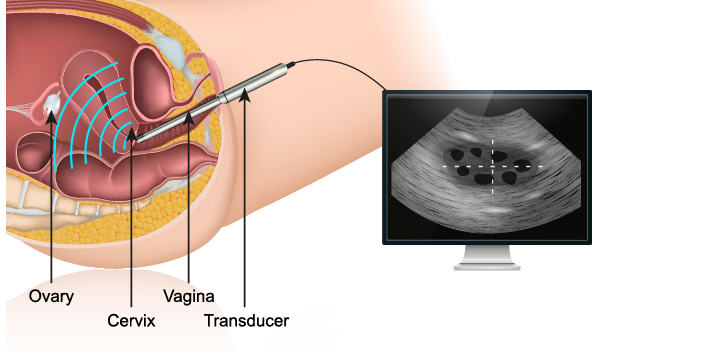Ultrasound is a diagnostic imaging tool to see into the body using sound waves. It can be done through the abdominal wall (transabdominal), through the vagina (transvaginal), or through the rectum (transrectal)
Ultrasound is a diagnostic imaging tool to see into the body using sound waves. Ultrasound can be done through the abdominal wall (transabdominal), through the vagina (transvaginal), or through the rectum (transrectal). It is a diagnostic test that does not involve any cuts on the body and scans usually lasts less than 30 minutes.
Ultrasound can be used to assess the pelvis in people with pelvic pain, which can be due to endometriosis. Other problems causing pelvic pain which can be also be assessed using ultrasound include adenomyosis, ovarian cysts, pelvic infections, and other rarer issues.
In the past, it was thought that endometriosis could only be diagnosed at the time of surgery but this is not true. While ultrasound is not perfect, it can diagnose two of the three main types of endometriosis (ovarian and deep) and other pelvic pain problems quite reliably, if the person performing and interpreting the scan is appropriately trained, helping get the patient the correct diagnosis and on the right treatment plan. The third type of endometriosis, superficial endometriosis, is still hard to diagnose using ultrasound but new techniques are being developed to close this remaining diagnostic gap.

When is ultrasound useful to diagnose endometriosis?
There has been a slow and steady increase in using imaging tests like ultrasound and magnetic resonance imaging (MRI) to assist with the diagnosis of endometriosis and surgery planning. The accuracy of ultrasound has been improving over the last 20 years. Ultrasound can usually detect ovarian endometriomas and deep endometriosis (also known as deeply infiltrating endometriosis).
These two types, when present, usually indicate moderate to severe endometriosis, so it is good that the imaging can detect them. Detecting these in a less-invasive fashion allows for optimal preparation for surgery, if surgery is ultimately the treatment of choice by the patient. Some patients will choose to receive their diagnosis and continue using medications and other holistic strategies to reduce their symptoms rather than surgery. Ultimately, it is up to the patient to decide what to do but a diagnosis using imaging allows for them to understand what is going on with more clarity than a diagnosis based on clinical symptoms and less risk than a diagnosis based on surgery.
Ultrasound is especially preferred in many places compared to MRI or surgery because it is safer, cheaper, and more accessible.
However, in some places, MRI is preferred based on the preference or skill of the local gynaecologist or radiologist. Both have high accuracy and may be interchangeable but it is important that the person performing and interpreting the results has the skill level to do so accurately.
Some specialty clinics in Australia provide ultrasound with sonographers (the people that do ultrasounds) that have done additional training to detect endometriosis.
What happens when you have an ultrasound for endometriosis?
Your GP or gynaecologist will provide you a referral to get an ultrasound for endometriosis. When booking your appointment, the clinic will advise you of any special preparations you need to complete prior to the ultrasound. The clinic will tell you whether you need a full bladder or an empty one. On the day of your appointment, you may be asked to change into a gown or will be shown to the room and asked to remove your pants/underwear and cover yourself with a sheet.
The sonographer may begin with a normal abdominal ultrasound where some gel will be put onto the device and this will be moved across your lower abdomen checking for the uterus and ovaries. Once the external ultrasound is complete, the sonographer will ask if they can begin the transvaginal ultrasound. Not all centres routinely use the external approach as some believe the internal transvaginal approach is superior and the external transabdominal component adds little information. It’s important to communicate with the sonographer if you don’t wish to proceed with the transvaginal ultrasound or if it feels uncomfortable.

With your consent, the sonographer will insert the device into the vagina so that they can examine the uterus, ovaries, bowel, bladder, ureters, uterosacral ligaments, and pouch of Douglas in more detail. Often, pushing with the probe is necessary to check if the organs are mobile or stuck with adhesions. Sometimes the sonographer will also push on the abdomen to try to show movement of the pelvic structures.
The dynamic nature of ultrasound is one of its strengths and plays a large role in understanding the status of the pelvic organs. The entire ultrasound will take on average 15-30 minutes. For those who may be unable to undergo a transvaginal ultrasound for whatever reason, a transrectal ultrasound can be done with a similarly high accuracy as transvaginal ultrasound. Not all sonographers are equipped in this technique, so it may be necessary to speak with your GP or gynaecologist about where this type of technique is offered.
Afterward, you will be able to change back into your clothes and leave the clinic. The sonographer will process and report on the video/images that were captured during the ultrasound. A report will be sent to your GP outlining any findings of endometriosis, and your GP will convey these results to you at your follow-up appointment. In some centres, the ultrasound is performed by the gynaecologist (someone who may be considered a gynaecological surgeon sonologist) and in these situations, you may get immediate feedback about the findings (even as the scan is happening!)
 Skip to main content
Skip to main content